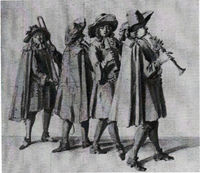Annotation:Oxford Waits: Difference between revisions
No edit summary |
m (Text replacement - "garamond, serif" to "sans-serif") |
||
| (2 intermediate revisions by one other user not shown) | |||
| Line 1: | Line 1: | ||
=='''Back to [[{{BASEPAGENAME}}]]'''== | =='''Back to [[{{BASEPAGENAME}}]]'''== | ||
---- | ---- | ||
<p><font face=" | <p><font face="sans-serif" size="4"> | ||
'''OXFORD WAITS.''' English, Country Dance Tune (cut time). G Major. Standard tuning (fiddle). AABB. Waits were groups of professional musicians sometimes employed by municipalities in England to play on public holidays, ceremonial, and state occasions, and to "sound the hours" to the general population. Waits in the town of Oxford were first mentioned in the year 1501 and firmly established by the time of Elizabeth I. They through the first decade of the 18th century, albeit in decline in their latter era. See also "[[Waits (The)]]" from Playford's '''Dancing Master''' (1665). | '''OXFORD WAITS.''' English, Country Dance Tune (cut time). G Major. Standard tuning (fiddle). AABB. Waits were groups of professional musicians sometimes employed by municipalities in England to play on public holidays, ceremonial, and state occasions, and to "sound the hours" to the general population. Waits in the town of Oxford were first mentioned in the year 1501 and firmly established by the time of Elizabeth I. They through the first decade of the 18th century, albeit in decline in their latter era. See also "[[London Waits]]," "[[Chester Waits]]," "[[Colchester Waits]]," and "[[Waits (The)]]" from Playford's '''Dancing Master''' (1665). | ||
[[File:waits.jpg|200px|thumb|left|English Waits c. 1680. A wash drawing attributed to Marcellus Laroon]] | |||
<br> | <br> | ||
<br> | <br> | ||
</font></p> | </font></p> | ||
<p><font face=" | <p><font face="sans-serif" size="4"> | ||
''Source for notated version'': | ''Source for notated version'': | ||
<br> | <br> | ||
<br> | <br> | ||
</font></p> | </font></p> | ||
<p><font face=" | <p><font face="sans-serif" size="4"> | ||
''Printed sources'': Walsh ('''The Third Book of the Compleat Country Dancing-Master'''), London, 1735; p. 170 (reissued in 1749). Daniel Wright ('''Wright's Compleat Collection of Celebrated Country Dances'''), London, 1740; p. 86. | ''Printed sources'': Walsh ('''The Third Book of the Compleat Country Dancing-Master'''), London, 1735; p. 170 (reissued in 1749). Daniel Wright ('''Wright's Compleat Collection of Celebrated Country Dances'''), London, 1740; p. 86. | ||
<br> | <br> | ||
<br> | <br> | ||
</font></p> | </font></p> | ||
<p><font face=" | <p><font face="sans-serif" size="4"> | ||
''Recorded sources'': <font color=teal></font> | ''Recorded sources'': <font color=teal></font> | ||
</font></p> | </font></p> | ||
Latest revision as of 14:32, 6 May 2019
Back to Oxford Waits
OXFORD WAITS. English, Country Dance Tune (cut time). G Major. Standard tuning (fiddle). AABB. Waits were groups of professional musicians sometimes employed by municipalities in England to play on public holidays, ceremonial, and state occasions, and to "sound the hours" to the general population. Waits in the town of Oxford were first mentioned in the year 1501 and firmly established by the time of Elizabeth I. They through the first decade of the 18th century, albeit in decline in their latter era. See also "London Waits," "Chester Waits," "Colchester Waits," and "Waits (The)" from Playford's Dancing Master (1665).

Source for notated version:
Printed sources: Walsh (The Third Book of the Compleat Country Dancing-Master), London, 1735; p. 170 (reissued in 1749). Daniel Wright (Wright's Compleat Collection of Celebrated Country Dances), London, 1740; p. 86.
Recorded sources:
